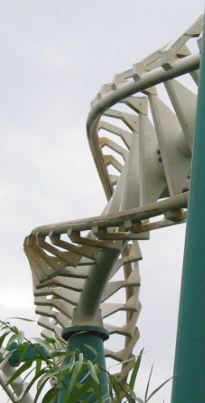


 "Project Helix" is the new roller coaster at
Liseberg for 2014. What is a helix?
"Project Helix" is the new roller coaster at
Liseberg for 2014. What is a helix?The roller coaster element "helix" is a turn of at least 360o resulting in an upward or downward spiral.
A slinky is an everyday example of a helix, as is the spiral in the body of the spiral rabbit, which can be used to visualize forces on the body, e.g. in a playground swing.
A helix can be righthanded or lefthanded. The mirror image of a righthanded helix is lefthanded - and vice versa.
Nature offers many examples of helices. The honey-suckle (which is also the "landscape flower" of Bohuslän) always grows in lefthanded helices, whereas e.g. bindweed and beans form righthanded helices. Seashells are righthanded, with very rare exceptions.
DNA - The Double Helix - carrying our genetic code is always righthanded, not unlike the screw from the Python at Efteling shown to the right.
The Heart-line roll in the Kanonen roller coaster at Liseberg also forms a righthanded helix, althoguh the body moves essentially in a "uniform rectilinear motion" during the rotation around an axis close to the level of the heart.
 Towards the end of the Lisebergbanan you enter a valley, followed by a righthanded ascending helix. This helix has a vertical axis, where the circles are close to horizontal. Other helices are found in corkscrews, as e.g. in the
Speedmonster at
Tusenfryd in Oslo, where the axis is horizontal and the circles ("loops") are vertical.
Towards the end of the Lisebergbanan you enter a valley, followed by a righthanded ascending helix. This helix has a vertical axis, where the circles are close to horizontal. Other helices are found in corkscrews, as e.g. in the
Speedmonster at
Tusenfryd in Oslo, where the axis is horizontal and the circles ("loops") are vertical.
Read more about Helicity and chirality - in physics, chemistry and life